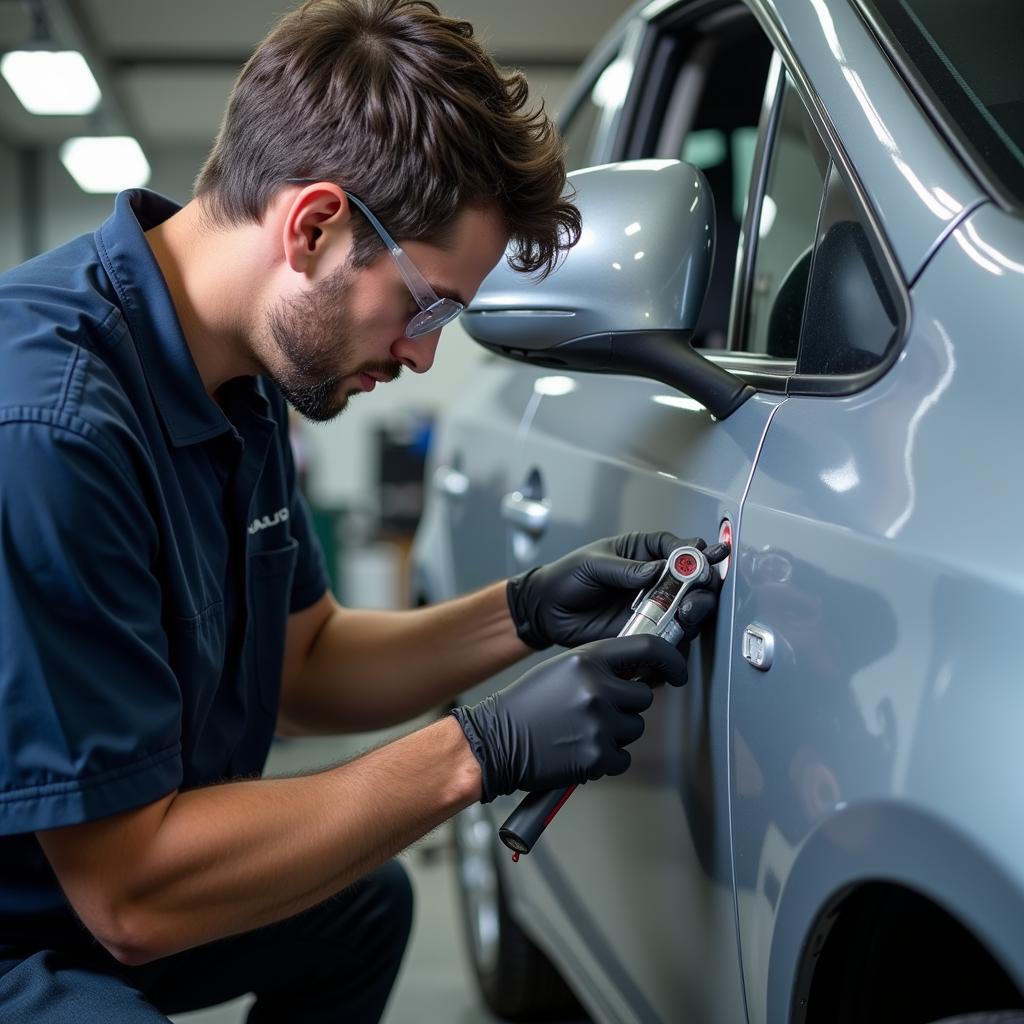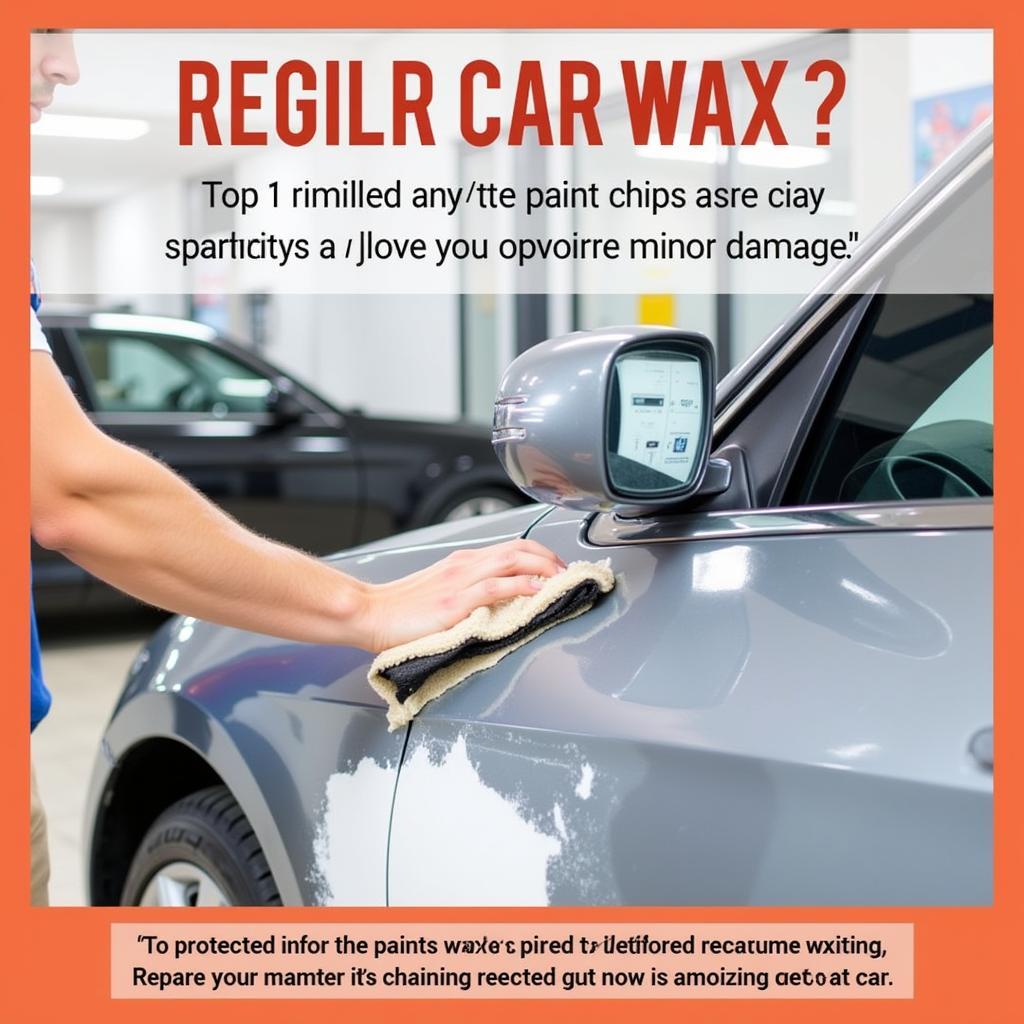
Professional car paint chip repair process
Repairing a paint chip on your new car can be a frustrating experience. However, addressing it quickly and effectively is crucial to prevent further damage like rust and maintain your car’s value. This guide will cover everything you need to know about repairing paint chips on a new car, from identifying the damage to choosing the right repair method.
Repairing minor paint chips can often be done at home, saving you the cost of a professional repair. However, for larger or more complex chips, seeking professional help is always recommended. Check out our car paint chip repair service new york for expert assistance.
Understanding Paint Chip Damage
Types of Paint Chips
Paint chips come in various sizes and depths. A minor chip might only affect the clear coat, while a deeper chip can expose the base coat or even the primer. Understanding the severity of the chip is vital in determining the appropriate repair method.
Why Prompt Repair is Important
Ignoring a paint chip, even a small one, can lead to bigger problems down the line. Exposed metal is susceptible to rust, which can spread and cause significant damage. Prompt repair not only preserves your car’s appearance but also protects its structural integrity.
You might also be interested in learning about more extensive repairs, like those covered in our guide on car rust and paint repair.
DIY Paint Chip Repair: A Step-by-Step Guide
Assessing the Damage
Before starting any repair, thoroughly clean the chipped area with soap and water. This removes any dirt or debris that could interfere with the repair process. Dry the area completely.
Gathering Your Supplies
For minor chips, a touch-up paint pen or kit is usually sufficient. Ensure you get the correct color code for your car. Other essential supplies include rubbing alcohol, fine-grit sandpaper, masking tape, and a microfiber cloth.
Repairing the Chip
- Apply masking tape around the chipped area to protect the surrounding paint.
- If the chip is deep, carefully sand the area with fine-grit sandpaper to smooth any rough edges. Be gentle to avoid further damage.
- Clean the area with rubbing alcohol.
- Apply the touch-up paint in thin layers, allowing each layer to dry completely before applying the next.
- Once the paint is dry, carefully remove the masking tape.
- If necessary, use rubbing compound and polishing compound to blend the repaired area with the surrounding paint.
For more comprehensive information on various car paint repair techniques, see our guide on how to repair the paint on a car.
When to Seek Professional Help
While DIY repairs are suitable for minor chips, larger or more complex chips require professional expertise. If the chip has exposed bare metal or if you’re uncomfortable with DIY repairs, it’s best to consult a professional.
“A professional repair ensures a seamless and long-lasting finish, especially for larger or more complicated paint chips,” says John Smith, Automotive Paint Specialist at Smith Auto Body.
 Professional car paint chip repair process
Professional car paint chip repair process
Preventing Paint Chips
Protecting your car’s paint from chips requires proactive measures. Regularly waxing your car provides a protective layer. Parking in covered areas or using a car cover can also help minimize the risk of chips from road debris or environmental factors.
“Regular maintenance like waxing and careful parking can significantly reduce the likelihood of paint chips,” advises Maria Garcia, Auto Detailing Expert at Garcia Auto Detailing.
 Preventing paint chips by waxing your car
Preventing paint chips by waxing your car
Conclusion
Repairing a paint chip on a new car is essential for maintaining its appearance and preventing further damage. Whether you choose a DIY approach or seek professional help, addressing the chip promptly is key. Regular car maintenance and preventative measures can also minimize the risk of future paint chips. For professional paint chip repair services in other locations, check out our resources on car paint chip repair cincinnati and car paint repair edinburgh.
FAQ
- Can I use nail polish to repair a paint chip? (No, nail polish is not formulated for automotive paint and will not provide a durable or matching repair.)
- How long does touch-up paint take to dry? (Touch-up paint typically dries within 30-60 minutes, but it’s best to allow several hours for complete curing.)
- Will a DIY repair be noticeable? (With careful application and blending, a DIY repair can be almost invisible. However, professional repairs generally offer a more seamless finish.)
- How much does professional paint chip repair cost? (The cost of professional repair varies depending on the size and location of the chip, but it typically ranges from $50 to $200.)
- How can I prevent paint chips on my new car? (Regular waxing, parking in covered areas, and using a car cover can help prevent paint chips.)
- What should I do if the chip has exposed bare metal? (If bare metal is exposed, it’s essential to address the chip promptly to prevent rust. A professional repair is usually recommended in this case.)
- Can I repair a paint chip in cold weather? (Touch-up paint may not adhere properly in cold temperatures. It’s best to repair the chip in a warm, dry environment.)
Common Scenarios and Questions
-
Scenario: A small rock chips the paint on your hood while driving on the highway.
-
Question: Can I fix this myself, or should I take it to a professional?
-
Scenario: You notice a small chip on your car door after parking in a crowded parking lot.
-
Question: What type of touch-up paint should I use?
-
Scenario: You accidentally scratch your car against a wall while parking.
-
Question: How deep of a scratch can I repair myself?
Further Exploration
You might also find these resources helpful:
- Articles on car detailing and maintenance
- Videos demonstrating paint chip repair techniques
- Forums and online communities discussing car care
Need further assistance? Contact us via WhatsApp: +1(641)206-8880 or Email: [email protected]. Our customer support team is available 24/7.
